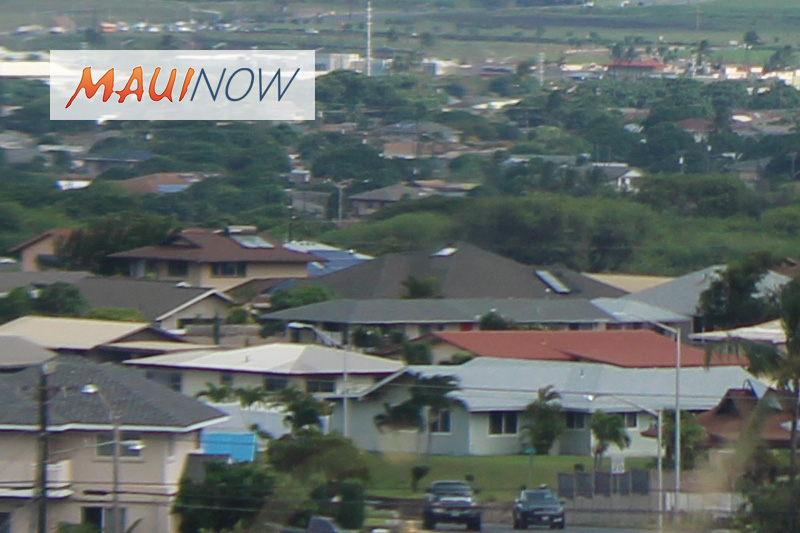Despite pushback, new affordable sales price guides for Maui County advance

Despite some who said the plan could actually hurt housing development, a Maui County Council committee on Thursday recommended approval of a measure that aims to make affordable housing more affordable.
The measure was recommended for approval by a 5-3 vote, with one council member absent and excused, during the council’s Affordable Housing Committee. It now heads to full council for first reading.
Bill 107 would change the Area Median Income price guidelines for affordable housing so sales price will be calculated based on total housing costs capped at 31% of gross annual income.
Also, it would bundle total housing costs to include principal, interest, taxes, insurance, private mortgage insurance and homeowner’s association dues.
The changes would result in a 22% decrease in affordable housing sales prices, according to Linda Munsell, deputy director of the county’s Housing and Human Concerns Department.
However, the department recommended a different route and cautioned the council to consider where the 22% will come from.
“As a county we need to very carefully consider the impact our decisions will have not only on our workforce buyers who are critically important to us but also on our partner developers,” Munsell said. “The cost of providing workforce housing at lower prices has to be made up in some fashion, whether it’s through increasing the price of the market units, assuming the market will bear such costs, or through a subsidy.”
Keoni Kuoha, director of Hawaiʻi Community Foundation’s Maui House Initiative, testified that while he appreciates the intent to lower prices for lower-income brackets, the bill would create a mandate without the resources to support the rule.
“While Bill 107 lowers the cost burden to our low-income buyers, my question is, ‘Where are the resources to make up the difference?’” he asked.
“My concern is that if this mandate is added to the current affordable housing provisions in our county laws, it’s actually going to stop any further affordable housing development because developers don’t know how to make the numbers add up,” Kuoha added.
Lawrence Carnicelli, Alaula Builders vice president of development, said the bill will hamper for-sale affordable housing. He told the council that affordable rental developers can rely on federal, state and county subsidies and should be considered in a different category than for-sale affordable developers.
“This bill basically what it does is say we’re going to magically make prices 22% cheaper,” he said.
He added that Maui doesn’t have a demand issue, it has a supply issue, and more homes need to be built.
Carnicelli advocated for a deferred payment mortgage program where county money can go directly to the buyers. Instead of buying down the price, buy down the interest rate from 6% to 4% or from 4% to 2%, he said.
“Give the money to the buyers,” he said.
Douglas Bigley, director and president of nonprofit developer Ikaika Ohana, said when homeownership is geared toward low, low income buyers, a challenge is the amount of subsidy per unit.
If a single-family home is being sold for $190,000, and the cost, excluding the land, to build it is $550,000 or $600,000, that’s a $330,000 subsidy per home, he said.
“If you burn through your affordable housing funds at that rate, it’s pretty fast,” Bigley added.
Council Member Shane Sinenci said that if the county has $56 million in the Affordable Housing Fund, it can build 280 units at a $200,000 subsidy per unit and 560 units at a $100,000 subsidy per unit.
“Just to put it in perspective,” he said.
Committee Chairman Gabe Johnson replied that his Bill 61, which expanded the uses of the Affordable Housing Fund to include long-term planning for affordable housing, houselessness solutions and infrastructure assessments, will help subsidize developments.
“When we look at that $58 million please don’t just think that that’s all we have,” Johnson said. “We have big purchasing power through bonds that we would pay off with the affordable housing fund principal and interest.”
Supporting votes Thursday included Council Members Johnson, Sinenci, Tamara Paltin, Keani Rawlins-Fernandez and Kelly Takaya King. Opponents were Council Members Yuki Lei Sugimura, Alice Lee and Mike Molina. Council Member Tasha Kama was absent and excused.
“The people of Maui County are really going to reap the benefits on this,” Johnson said after the vote.
During an Affordable Housing Committee meeting in May, financing and housing presenters discussed updating the county’s rent and sales price guidelines so more federal resources are available to the community and prices are actually affordable.
The recently published Comprehensive Affordable Housing Plan advises that the county update its rent and sales price guidelines to come up with prices that include principal, interest, taxes, insurance, mortgage insurance and HOA fees capped at 31% of the homeowner’s gross income.
Johnson during that meeting said that there are two major factors in determining the price of an affordable home.
The first factor is Area Median Income, a federally produced number, which can be problematic. Many experts believe those numbers are artificially high, but Johnson said that topic will be discussed in the future.
The second factor is the formula the county Housing department has been using to calculate the affordable sales price. The county starts with income levels given by the US Department of Housing and Urban Development. Then, it calculates what a person at that income level can afford to pay for a home.
“We have the power to change that, to make it more accurate, to make it conform to mainstream mortgage standards, giving our local families an increased ability to use federal mortgage programs that allow for home ownership with low or no downpayment requirements,” Johnson had said. “By simply changing the formula we use based on the federal program standards, we can make affordable homeownership accessible to more people.”








